Planting tuberose and caring for perennials in the open field
 Planting tuberose and care in the open field does not present any particular difficulties even for novice flower growers. Therefore, this plant is gradually recovering its undeservedly lost popularity. Indeed, few horticultural crops are distinguished by such a long flowering, which is accompanied by an exquisite aroma.
Planting tuberose and care in the open field does not present any particular difficulties even for novice flower growers. Therefore, this plant is gradually recovering its undeservedly lost popularity. Indeed, few horticultural crops are distinguished by such a long flowering, which is accompanied by an exquisite aroma.
Botanical description

There are about 13 types of tuberose in nature, but in horticulture, tuberous polyanthes is most common.
The root system of the plant is an oblong bulb up to 6 cm long. Long thin roots extend from its lower part, which extract nutrients and moisture from the soil. The life cycle of a tuber is 2 years. During this time, the uterine bulb actively forms babies, and then dies off.
 The plant reaches a height of 0.45-0.5 m. The aerial part of tuberose is renewed annually, and flowering occurs only when the diameter of the bulb reaches 3.5-4 cm. The culture forms strong erect shoots, which are bare in the upper part. At the base of the bush are narrow, dark green leaves. The length of the tuberose plates reaches 35-40 cm, and the width is 1-3 cm.
The plant reaches a height of 0.45-0.5 m. The aerial part of tuberose is renewed annually, and flowering occurs only when the diameter of the bulb reaches 3.5-4 cm. The culture forms strong erect shoots, which are bare in the upper part. At the base of the bush are narrow, dark green leaves. The length of the tuberose plates reaches 35-40 cm, and the width is 1-3 cm.
In the middle of summer, tuberose begins to form spike-shaped inflorescences at the tops of the shoots and continues until the end of October. During this period, the plant height is about 1 m. The inflorescence consists of 10-30 buds, each of them blooms within 2-3 days. At the same time, the plant exudes a pleasant aroma, which intensifies in the evening and after rain. The scent of tuberose is similar to daffodil, gladiolus, which contributed to the widespread use of this flower in the perfume industry.
 The buds are initially pale pink, and upon opening they acquire a light shade. The flowers are elongated, tubular with pointed petals. Their size is 5-6 cm, and the diameter when opened is about 4 cm.
The buds are initially pale pink, and upon opening they acquire a light shade. The flowers are elongated, tubular with pointed petals. Their size is 5-6 cm, and the diameter when opened is about 4 cm.
The flowering period of tuberose lasts 2.5 months.
Planting tuberose and outdoor care
 This perennial is not picky about care. But in order for the plant to fully develop and bloom profusely, it is necessary to choose the right place for it on the site and take into account the basic requirements of the culture.
This perennial is not picky about care. But in order for the plant to fully develop and bloom profusely, it is necessary to choose the right place for it on the site and take into account the basic requirements of the culture.
Dates of planting in open ground
 Tuberose does not overwinter in the open field, since the plant does not belong to the category of frost-resistant. Therefore, perennial bulbs must be planted in open ground in spring, when the soil warms up to a depth of 10 cm to +10 degrees. A favorable period for planting is the end of April and throughout May, depending on the region where polyanthes or tuberose is grown.
Tuberose does not overwinter in the open field, since the plant does not belong to the category of frost-resistant. Therefore, perennial bulbs must be planted in open ground in spring, when the soil warms up to a depth of 10 cm to +10 degrees. A favorable period for planting is the end of April and throughout May, depending on the region where polyanthes or tuberose is grown.
This plant reacts poorly to returnable spring frosts.
Tuber preparation and site selection

To accelerate the germination of tubers, experienced growers recommend pre-warming them:
- For this, tuberose bulbs should be wrapped in a damp cloth and placed in a warm shaded place with a temperature of +25 degrees.
- Under these conditions, roots begin to appear after 10 days.
- After that, the bulbs must be planted in open ground.
The place for tuberose should be chosen open, protected from cold gusts of wind.In this case, light shading is allowed at noon hours.
 Tuberose should be grown in loamy or sandy loam soil with a low acidity level. In this case, it is necessary that the soil has good air permeability.
Tuberose should be grown in loamy or sandy loam soil with a low acidity level. In this case, it is necessary that the soil has good air permeability.
 The site for planting tuberose should be prepared at least two weeks in order for the soil to settle. It needs to be dug up and rotted organic matter added at the rate of 5 kg per 1 sq. m. It is also additionally necessary to add 30 g of superphosphate and 20 g of potassium sulfide for the same area.
The site for planting tuberose should be prepared at least two weeks in order for the soil to settle. It needs to be dug up and rotted organic matter added at the rate of 5 kg per 1 sq. m. It is also additionally necessary to add 30 g of superphosphate and 20 g of potassium sulfide for the same area.
Landing features
 Immediately before planting, perennial tubers must be kept in a pink solution of potassium permanganate for 15 minutes. This procedure allows you to prevent their defeat by fungal diseases at the initial stage of development. After that, the planting material must be rinsed with plain water and dried slightly.
Immediately before planting, perennial tubers must be kept in a pink solution of potassium permanganate for 15 minutes. This procedure allows you to prevent their defeat by fungal diseases at the initial stage of development. After that, the planting material must be rinsed with plain water and dried slightly.
With prolonged stagnation of moisture in the soil, tuberose bulbs rot.
Landing Algorithm:
- Make holes at a distance of 15-20 cm from each other.
- Pour a layer of sand 1 cm thick at the bottom.
- Place the onion in the center, sprinkle it with earth.
- Slightly compact the surface, water the garden bed.
Knowing what tuberose is, and how to plant it, you should also familiarize yourself with the rules for caring for the plant.
Features of further care
 The tuberose bulbous plant does not require special attention from the grower. But in order for the plant to bloom profusely, it is necessary not only to properly plant tuberose in open ground, but also to provide care.
The tuberose bulbous plant does not require special attention from the grower. But in order for the plant to bloom profusely, it is necessary not only to properly plant tuberose in open ground, but also to provide care.
 Watering a perennial is necessary only with prolonged drought. To do this, use settled water with a temperature of +20 degrees. Moisturize 1-2 times a week. Withered flower stalks need to be cut regularly, which stimulates the formation of new buds.
Watering a perennial is necessary only with prolonged drought. To do this, use settled water with a temperature of +20 degrees. Moisturize 1-2 times a week. Withered flower stalks need to be cut regularly, which stimulates the formation of new buds.
 It is necessary to feed the plant twice a season if fertilizers were applied during planting. The first time you need to do this before flowering. During this period, fermented organic matter should be used. Fertilizer should be applied a second time at the end of flowering. At this time, you need to apply phosphorus-potassium mineral mixtures, which will improve the storage of bulbs in winter.
It is necessary to feed the plant twice a season if fertilizers were applied during planting. The first time you need to do this before flowering. During this period, fermented organic matter should be used. Fertilizer should be applied a second time at the end of flowering. At this time, you need to apply phosphorus-potassium mineral mixtures, which will improve the storage of bulbs in winter.
Shoots of tuberose can break under gusts of wind, so they must be tied to a support.
Storing tubers in winter
 In the second half of October, when the foliage turns yellow, it is necessary to dig out the tuberose tubers. This should be done before the onset of the first frost, or after them. Tubers need to be carefully peeled from the ground and dried for several days. They should be stored in boxes in the basement. The optimal mode is temperature +10 degrees and humidity 70%.
In the second half of October, when the foliage turns yellow, it is necessary to dig out the tuberose tubers. This should be done before the onset of the first frost, or after them. Tubers need to be carefully peeled from the ground and dried for several days. They should be stored in boxes in the basement. The optimal mode is temperature +10 degrees and humidity 70%.
Reproduction
 To obtain new tuberose seedlings, use the baby bulbs that grow on the mother's tuber. Planting and caring for young tuberose seedlings in the open field is the same as for adult plants. They should be separated in the spring, since any damage in the fall can cause decay. Such bulbs bloom only when they reach the required size. This usually happens 2-3 years after planting.
To obtain new tuberose seedlings, use the baby bulbs that grow on the mother's tuber. Planting and caring for young tuberose seedlings in the open field is the same as for adult plants. They should be separated in the spring, since any damage in the fall can cause decay. Such bulbs bloom only when they reach the required size. This usually happens 2-3 years after planting.
Even experienced flower growers do not practice growing tuberose from seeds. This is due to the fact that this process is very long and laborious.
Pests and diseases
 The persistent aroma of tuberose repels many pests. But the danger for this plant is the bear and the root mite, which damage the tubers. To combat pests, it is recommended to lay insecticide "Thunder" granules in the holes when planting, and also water the plant several times a season with a working solution "Neoron", "Nugor" or "Tagore".
The persistent aroma of tuberose repels many pests. But the danger for this plant is the bear and the root mite, which damage the tubers. To combat pests, it is recommended to lay insecticide "Thunder" granules in the holes when planting, and also water the plant several times a season with a working solution "Neoron", "Nugor" or "Tagore".
In the case of a cool, wet summer, the plant can be affected by fungal diseases. During the season, it is necessary to water the plant.Fitosporin"Or" Maxim ".
Tuberose is able to decorate any home plot with its appearance.It goes well with gladioli, but blooms much longer, which allows you to preserve the decorativeness of the flower bed until late autumn. Despite the peculiarities of cultivation, tuberose is not one of the capricious crops, so the plant does not cause much trouble for the gardener.